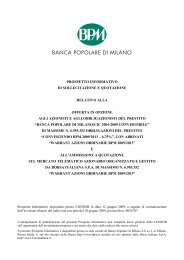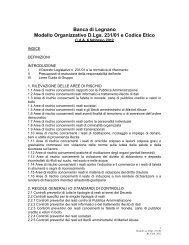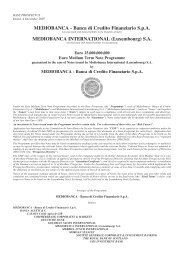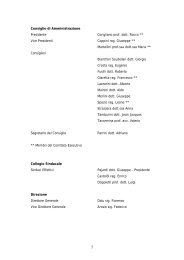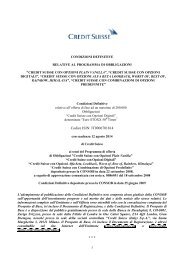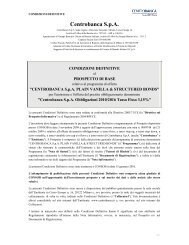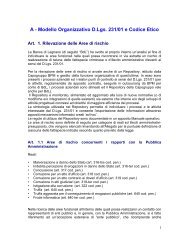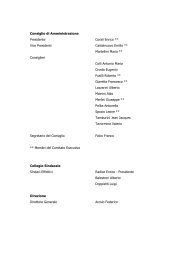INDEX OF DEFINED TERMS - Banca di Legnano
INDEX OF DEFINED TERMS - Banca di Legnano
INDEX OF DEFINED TERMS - Banca di Legnano
You also want an ePaper? Increase the reach of your titles
YUMPU automatically turns print PDFs into web optimized ePapers that Google loves.
Level: 2 – From: 2 – Wednesday, July 21, 2010 – 14:35 – eprint6 – 4247 Section 03<br />
Regulatory Matters<br />
that financial hol<strong>di</strong>ng companies should maintain a Tier 1 common capital ratio of at least four per cent.<br />
The Tier 1 common capital ratio is determined by <strong>di</strong>vi<strong>di</strong>ng Tier 1 common capital by risk weighted assets.<br />
The Issuer calculates Tier 1 common capital as Tier 1 capital, which includes CES, less preferred stock,<br />
trust preferred securities, hybrid securities and noncontrolling interest. As of December 31, 2009, the<br />
Issuer’s Tier 1 common capital ratio was 7.81 per cent.<br />
The leverage ratio is determined by <strong>di</strong>vi<strong>di</strong>ng Tier 1 capital by adjusted quarterly average total assets,<br />
after certain adjustments. Well-capitalized bank hol<strong>di</strong>ng companies must have a minimum Tier 1 leverage<br />
ratio of three per cent. and not be subject to a Federal Reserve Board <strong>di</strong>rective to maintain higher capital<br />
levels. The Issuer’s leverage ratio at December 31, 2009 was 6.91 per cent., which exceeded its leverage<br />
ratio requirement.<br />
The Federal Deposit Insurance Corporation Improvement Act of 1991 (“FDICIA”), among other<br />
things, identifies five capital categories for insured depository institutions (well capitalized, adequately<br />
capitalized, undercapitalized, significantly undercapitalized and critically undercapitalized) and requires<br />
the respective federal regulatory agencies to implement systems for “prompt corrective action” for insured<br />
depository institutions that do not meet minimum capital requirements within such categories. FDICIA<br />
imposes progressively more restrictive constraints on operations, management and capital <strong>di</strong>stributions,<br />
depen<strong>di</strong>ng on the category in which an institution is classified. Failure to meet the capital guidelines could<br />
also subject a banking institution to capital-raising requirements. An “undercapitalized” bank must develop<br />
a capital restoration plan and its parent hol<strong>di</strong>ng company must guarantee that bank’s compliance with the<br />
plan. The liability of the parent hol<strong>di</strong>ng company under any such guarantee is limited to the lesser of five<br />
per cent. of the bank’s assets at the time it became “undercapitalized” or the amount needed to comply<br />
with the plan. Furthermore, in the event of the bankruptcy of the parent hol<strong>di</strong>ng company, such guarantee<br />
would take priority over the parent’s general unsecured cre<strong>di</strong>tors. In ad<strong>di</strong>tion, FDICIA requires the various<br />
regulatory agencies to prescribe certain non-capital standards for safety and soundness relating generally to<br />
operations and management, asset quality and executive compensation, and permits regulatory action<br />
against a financial institution that does not meet such standards.<br />
The various regulatory agencies have adopted substantially similar regulations that define the five<br />
capital categories identified by FDICIA, using the total risk-based capital, Tier 1 risk-based capital and<br />
leverage capital ratios as the relevant capital measures. Such regulations establish various degrees of<br />
corrective action to be taken when an institution is considered undercapitalized. Under the regulations, a<br />
“well capitalized” institution must have a Tier 1 risk-based capital ratio of at least six per cent., a total<br />
risk-based capital ratio of at least ten per cent. and a leverage ratio of at least five per cent. and not be<br />
subject to a capital <strong>di</strong>rective order. Under these guidelines, each of the Issuer’s banking subsi<strong>di</strong>aries was<br />
considered well capitalized as of December 31, 2009.<br />
Regulators also must take into consideration: (a) concentrations of cre<strong>di</strong>t risk; (b) interest rate risk;<br />
and (c) risks from non-tra<strong>di</strong>tional activities, as well as an institution’s ability to manage those risks, when<br />
determining the adequacy of an institution’s capital. This evaluation is made as a part of the institution’s<br />
regular safety and soundness examination. In ad<strong>di</strong>tion, the Issuer, and any of its banking subsi<strong>di</strong>aries with<br />
significant tra<strong>di</strong>ng activity, must incorporate a measure for market risk in their regulatory capital<br />
calculations.<br />
In ad<strong>di</strong>tion, in June 2004, the Basel Committee on Banking Supervision published Basel II, which<br />
is designed to address cre<strong>di</strong>t risk, market risk and operational risk in the international banking markets. In<br />
December 2007, U.S. banking regulators published Basel II final rules which require the Issuer and certain<br />
of its U.S. banking subsi<strong>di</strong>aries to implement Basel II. In December 2009, the Basel Committee on<br />
Banking Supervision released consultative documents on both capital and liqui<strong>di</strong>ty. Ad<strong>di</strong>tionally, U.S.<br />
banking regulators continue to refine market risk requirements, which also have a regulatory capital<br />
impact. Revised requirements have not been issued but are expected in 2010.<br />
45



